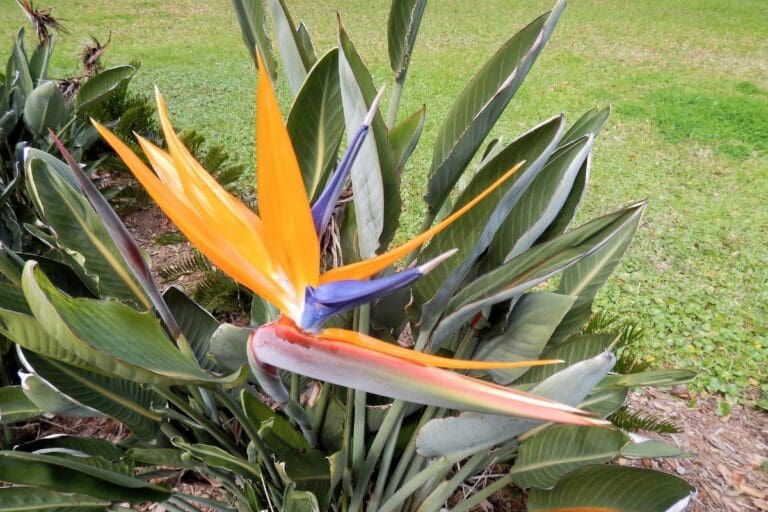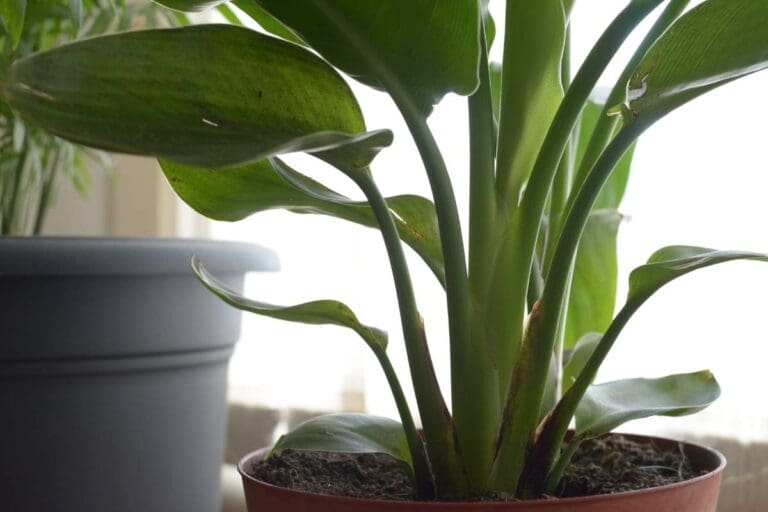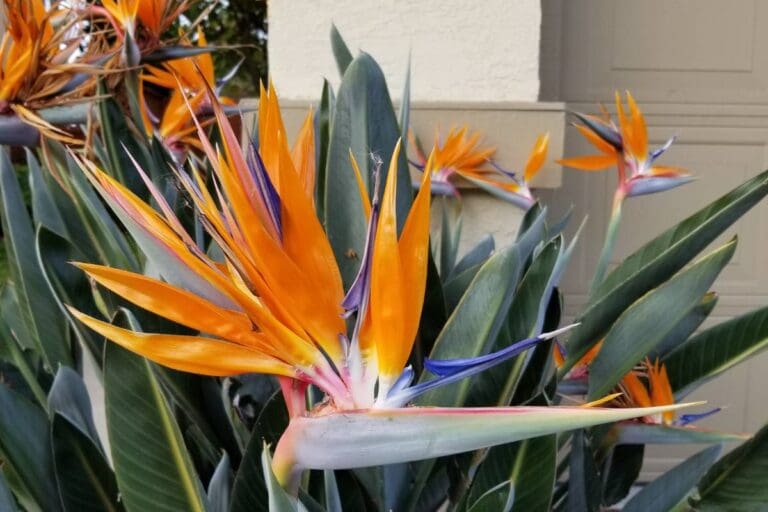How Much Light Does A Bird Of Paradise Need?
Are you a proud Bird of Paradise owner like myself? It’s a beautiful plant that transforms the look of our indoor spaces. But one thing that bothered me for a while was how much light the Bird of Paradise needs. That’s what we’ll find out.
A Bird of Paradise needs 6-8 hours of medium light to thrive. It can do well in direct and indirect sunlight when acclimated, but the direct sunlight should not be so intense that its leaves get scorched. The light intensity between 400-800 Foot Candles is ideal for this plant.
There are a few things you should know about fulfilling the light requirements of the Bird of Paradise plant. Keep reading as I will discuss everything you need to know.

Please note: Simplify Plants is reader-supported. Some links in the post are affiliate links and I get a commission from purchases made through links in the post.
How much light does my Bird of Paradise need?
The Bird of Paradise is a hardy and beautiful plant that can tolerate a wide range of lighting conditions.
The plant does best with 6-8 hours of sunlight.
If you have a light meter, you can also check the intensity of the light.
The ideal range for a Brid of Paradise should be between 400-800 foot candles.
If you are new to this and don’t know what these light intensities mean, this table can help.
| Light intensity | Type of light |
|---|---|
| 32,000-1,00,000 | Direct sunlight |
| 10,000-25,000 | Partial sunlight |
| 500-1000 | Medium-light |
| 100-500 | Low light |
| <100 | Little or no light |
From this, you can understand that a Bird of Paradise requires medium light to thrive.
Bird of Paradise is mostly an outdoor plant, so if you have yours outside, don’t worry, as it can tolerate direct sunlight.
However, planting it in a shaded spot where it gets some shade from the leaves of other trees can save it from the extreme sunlight that can burn its leaves.
And if you plan to shift your indoor Bird of Paradise to outdoor, make sure you do it gradually and not shift it suddenly under a lot of direct sunlight.
Start by keeping the plant outside for a few hours under the direct morning sun and bring it inside after 3-4 hours.
Continue this for a few days and then increase the time gradually.
Once the plant has adjusted completely and does not show any problems, you can leave it outside.
Can my Bird of Paradise survive in low light?
I already mentioned that Bird of Paradise is a hardy plant that can tolerate different lighting conditions.
That includes low-light spots that are partially shaded.
However, it won’t be the best for its growth.
If you are fond of your Bird of Paradise flowers, you might notice a slower growth when placed in low light.
If that is not an issue, you can keep the plant in a low-light spot but ensure it gets enough light to sustain itself and stay healthy.
How do I know if my Bird of Paradise is getting enough light?
It might not be possible for our human eyes to determine how much light our Bird of Paradise is getting, but there are ways to find that out.
1. Use a light meter
Getting a light meter can be a great investment if you are a plant lover and have many indoor plants in your home.
Once you get the light meter, also called the Lux meter, you can check the intensity of light that your Bird of Paradise gets.
Here’s how you can use it:
- Remove the cap that covers the sensor of the meter.
- Turn the meter on.
- Select how you want to measure the light (Foot candles or lux)
- You might need to adjust the range if it is too low. You will need to increase it with the “Range’ button.
- Avoid pointing the sensor toward the plant, as that will not give the right reading. Instead, point the sensor toward the light source.
- Now, check the readings. You can refer to the above table to understand what kind of light your Bird of Paradise is getting.
2. Check the shadow
If you don’t have a light meter, use your hand to do the shadow test.
Let’s see how we can do this:
- Bring your hand between the light source (for example, window or balcony) and the plant.
- Now check the shadow of your hand.
- If the shadow is clear and crisp, the intensity of the light is high. The intensity is on the lower side if the shadow is blurry.
- It might not give you the exact idea, but you can move the plant around based on the shadow and how your skin feels. If the light feels very harsh on the skin, you can move the plant away from it. The light should feel comfortable on the skin.
Where should I place my Bird of Paradise?

While finding the right placement for the Bird of Paradise, you must consider the lighting.
That is the primary factor, followed by temperature and humidity.
You can place it near an eastern, southern, or western window.
Find a spot in your house that gets 6-8 hours of sunlight but make sure that the plant is not exposed to the direct sun rays in the afternoon, especially during summer.
Also, keep the plant away from drafts and temperature fluctuations.
How do I know if my Bird of Paradise is getting too much light?
A Bird of Paradise thrives in medium light and doesn’t prefer direct sunlight that is too intense.
If it does get too much light, it will show you certain signs:
1. Curling leaves
One of the primary signs of excess sunlight exposure is curling leaves.
Although curling leaves can signify other issues, it mainly happens when the plant gets too much light and loses a lot of water through the leaves.
The curling leaves are the mechanism through which plants try to retain the water and prevent further loss.
Check the light and move the Bird of Paradise to a better spot if the light is too intense.
2. Yellow leaves
Yellow leaves can also signify that your Bird of Paradise is getting too much light.
The soil starts drying up when the sunlight is too intense, and the leaves get scorched.
Their color fades from green to yellow.
3. Brown tips and edges

It can either happen due to underwatering or excess sun exposure.
And both go hand in hand.
If your Bird of Paradise gets too much light, the excess heat will absorb excess water from the soil and the leaves.
As a result, you will see brown tips and edges on the leaves.
4. Falling leaves
Another sign of too much sun exposure is falling leaves.
If your Bird of Paradise stays under intense afternoon sunlight and you don’t do anything about it, the leaves will get affected.
They will dry out and fall off the plant.
5. Slow and distorted growth
When your Bird of Paradise gets too much light, its leaves and stems shrink.
The excess light and heat increase the transpiration rate that the plant finds hard to keep up with.
This leads to slow and distorted growth.
How do I save my Bird of Paradise from excess light?
If the plant is getting excess sunlight, you must move it from its current spot.
Find another spot that doesn’t get the harsh direct sunlight and move your Bird of Paradise there.
How do I know my Bird of Paradise is getting too little light?

Too much light is extremely bad for your plant’s health but so is too little light.
If your Bird of Paradise is not getting enough light, you might notice these signs:
1. Damp soil
If your Bird of Paradise is not getting enough light, the soil will take a long time to dry.
You will notice that the soil is damp for days or even weeks.
2. Brown leaves
Brown leaves are a sign that your plant is not getting enough light.
When the plant doesn’t get enough light, the leaves lose color and turn brown.
3. Leggy growth
If your Bird of Paradise is placed in a spot that doesn’t get enough light, you will notice that it will soon start to stretch toward the light source.
This will make the stems long and thin with fewer leaves.
Not only will this affect the look of the plant but also its health.
4. Smaller leaves
When your Bird of Paradise doesn’t get enough light, it will not be able to produce enough food due to the lack of photosynthesis.
Due to lack of energy, you will notice smaller leaves on your Bird of Paradise.
5. Droopy leaves
The big beautiful leaves of your Bird of Paradise can droop if the plant doesn’t get enough light.
It happens when you place it in a low-light or completely shaded spot.
How do I provide more light to my Bird of Paradise?

If your Bird of Paradise is not getting enough light, consider moving it to a brighter place in the house.
If you have a window or a balcony, try to move it near them.
But if your house doesn’t get enough natural light, consider taking the help of artificial lights.
You can get them online or purchase them from a nearby garden center.
Final words
Bird of Paradise is a beautiful plant that can tolerate different lighting conditions but if you want it to thrive, consider exposing it to medium light. It can tolerate direct sunlight, but that shouldn’t be too extreme.
If your Bird of Paradise gets too much light, move it to a spot with less intense light and if it gets too little light, consider using artificial lights. And to understand how much light the plant is getting, use a light meter or conduct the shadow test.
Besides the lighting, ensure your Bird of Paradise gets the right temperature, humidity, and nutrition to stay healthy and happy.
What is the growth rate of a Bird of Paradise?
If your Bird of Paradise gets all the right conditions, it can grow 1-2 feet tall yearly.
Can Bird of Paradise grow in artificial light?
Yes, if your Bird of Paradise is not getting enough natural light, you can support it with artificial light. You must select the right artificial light, set a distance of 6 inches, ensure the right temperature, and use it for 12-16 hours.
Reference: Wikipedia, University of Florida, Strelitzia reginae, Britannica.
Recommended Garden Supplies
| Product Image | Our Recommended Gardening Supplies | Check Offers! |
|---|---|---|
Top Top
Top
Top
Top
Top
Top
Top
Top | rePotme Houseplant and Tropical Classic Potting Soil Mix | Check Offer On Amazon |
 Top
Top
Top
Top
Top
Top
Top
Top | Espoma Organic Indoor Plant Food | Check Offer On Amazon |
 Top
Top
Top
Top
Top
Top
Top
Top | GooingTop LED Grow Light 6000K Full Spectrum Clip Plant Growing Lamp | Check Offer On Amazon |
 Top
Top
Top
Top
Top
Top
Top
Top | Soil Moisture Meter | Check Offer On Amazon |
 Top
Top
Top
Top
Top
Top
Top
Top | Govee Hygrometer Thermometer, Bluetooth Enabled! | Check Offer On Amazon |
 Top
Top | LEVOIT Humidifiers for Large Room(Best For Plants) | Check Offer On Amazon |
 Top
Top
Top
Top
Top
Top
Top
Top | Upgraded DIY Automatic Drip Irrigation Kit, 15 Potted Houseplants Support | Check Offer On Amazon |
 Top
Top
Top
Top
Top
Top
Top
Top | Stainless Steel Heavy Duty Gardening Tool Set | Check Offer On Amazon |
 Top
Top
Top
Top
Top
Top
Top
Top | Bonide Insecticidal Soap | Check Offer On Amazon |
 Top
Top
Top
Top
Top
Top
Top
Top | Bonide 32 oz Spray Neem Oil for Organic Gardening | Check Offer On Amazon |
 Top
Top
Top
Top
Top
Top
Top
Top | Garden Safe Fungicide | Check Offer On Amazon |






